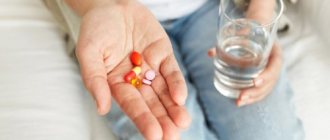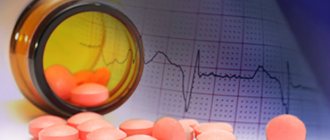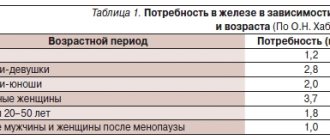Synthetic hypoglycemic agents[edit | edit code]
Insulin, as a high-molecular protein, acts only when administered parenterally, so treatment for diabetes mellitus is greatly facilitated by hypoglycemic agents that are effective when taken orally; these include guanidine and sulfonylurea derivatives, etc. The main indication for their use is type II diabetes mellitus.
Classification of synthetic hypoglycemic agents
- Biguanide derivatives - metformin
hydrochloride (dianormet, siofor, glucophage), buformin (adebit). - Sulfonylurea derivatives: Second generation (glibenclamide, glipizide, gliquidone, gliclizide);
- Third generation (glimepiride, amaryl).
).
Metformin hydrochloride[edit | edit code]
Pharmacokinetics
. About 60% of metformin is absorbed in the small intestine. It is not metabolized in the liver, does not bind to blood plasma proteins, quickly penetrates various organs, reaching maximum concentration in the intestinal epithelium. It is excreted unchanged in the urine. The maximum concentration in blood plasma is observed 2-4 hours after administration, the half-life is about 3 hours.
The mechanism of antidiabetic action consists of reducing appetite, inhibiting the absorption of carbohydrates in the intestines, inhibiting glucagon biosynthesis, increasing tissue glucose consumption, inhibiting glyconeogenesis in the liver and releasing glucose by the liver. By blocking oxidative processes, it stimulates anaerobic glycolysis. Does not affect the specific properties of insulin (its biosynthesis and biotransformation).
Indications for use
: diabetes mellitus type II, obesity.
Sulfonylurea derivatives are water-insoluble crystalline substances that cause moderate hypoglycemia. They stimulate the synthesis and release of endogenous insulin and eliminate the sluggish response of the insulin secretory apparatus to hyperglycemia characteristic of diabetes. Restores the sensitivity of glycoreceptors of insulinocytes of pancreatic islets, which is reduced in diabetes, through which the effect of hyperglycemia on insulin biosynthesis is realized. Their antidiabetic effect is also associated with the release of insulin from association with plasma proteins, with the stabilization of endogenous insulin, inhibition of the activity of insulinase and glucose-6-phosphatase, inhibition of glucagon biosynthesis and a decrease in the tone of the sympathoadrenal system. Drugs in this group differ from each other in certain pharmacodynamic features. For example, sulfonylurea derivatives (glibenclamide, glibornuride, gliclazide and other second-generation drugs) do not potentiate the insulin secretory effect of glucose, but are effective when the body is resistant to first-generation drugs (butamide, bucarban, cyclamide, chlocyclamide, chlorpropamide, etc.).
Glibenclamide (daonil, maninil, euglucon)[edit | edit code]
With T1/2 equal to 10-15 hours, it is possible to take it once. The drug inhibits platelet aggregation and also has a hypocholesterolemic effect. Blocks ATP-dependent K+ channels (3-cells of the islets of Langerhans. Depolarizes the membranes of (3-cells, opens voltage-dependent Ca2+ channels, increasing the level of calcium inside the cell, promotes the release of insulin (3-cells of the islets of the pancreas. Stimulates the proliferation of islet cells, inhibits secretion insulin antagonist - glucagon.
The drug is indicated for type II diabetes mellitus.
Side effects
: hypoglycemia, nausea, vomiting, diarrhea, photosensitivity, thrombocytopenia.
Amino acid derivatives
(repaglinide, pateglinide) block ATP-dependent β-cells and increase their sensitivity to glucose. They have a short latency period and a long duration of action.
Thiazolidinediones (pioglitazone, rosiglitazone)
increase the release of insulin by β-cells of the islets of Langerhans, as well as the sensitivity of insulin-dependent tissues to insulin, sensitizing insulin receptors. The mechanism of action is associated with the effect on peroxisome activator receptors.
Second generation sulfonylureas (in addition to glibenclamide) also include gliclazide
(diamicron, predian, diabetes),
gliquidone (glyurenorm)
,
glipized (glibinez, minidiab)
,
glisoxepide (prodiaban)
.
Acarbose (glucobay)
inhibits the activity of a-glucosidase, which is involved in the decomposition of di-, oligo- and polysaccharides. This leads to a slowdown in the absorption of carbohydrates and reduces the absorption of glucose from saccharides. The drug reduces daily fluctuations in blood sugar and leads to a decrease in its average level.
Pharmacokinetics
: the active substance - acarbose - is practically not absorbed and has an effect in the intestinal lumen. Bioavailability is 1-2%.
Side effects
: pain in the epigastric region, flatulence, diarrhea. When taking the drug in high doses, it is possible to increase the activity of liver transaminases.
ORAL GLOW-LOWERS: DRUGS OF CHOICE
Preferanskaya Nina Germanovna
Senior Lecturer, Department of Pharmacology, Faculty of Pharmacy, MMA named after. THEM. Sechenova, Ph.D.
Glucagon
, produced in a-cells, increases blood glucose levels.
Insulin is synthesized by b-cells and lowers blood glucose levels. insulin
differs from animal insulin in one or more amino acid residues.
Insulin secretion is a Ca2+-dependent process of a “pulsatile” nature, with a period of 15–30 minutes. During the day, 5 mg of insulin is released into the systemic circulation. The determining factor in the regulation of insulin is the level of glucose in the blood plasma. The normal blood glucose concentration is maintained at a constant level and is 3.3–3.5 mmol/l. The term “diabetes mellitus” (mellitus mellitus, diabetes mellitus)
combines several syndromes (a combination of symptoms), characteristic of this disease are hyperglycemia, impaired metabolism of carbohydrates, proteins and lipids. A multifactorial disease occurs with reduced function of b-cells, with impaired glucose tolerance, with a pronounced hereditary predisposition, obesity, physical inactivity, etc. The main properties of the hormone insulin are: stimulation of the formation of glycogen in the liver from glucose; inhibition of the conversion of glycogen into glucose; suppression of glucose formation from proteins and fats; stimulation of the transition of glucose from the blood to tissues, as a result of increasing the permeability of cell membranes for glucose. Body tissues (muscles, liver, etc.) with a lack of insulin are not able to use glucose even when its content in the blood is high. This phenomenon is called “hunger amid plenty.” Diabetes is manifested by hyperglycemia (glucose content in blood plasma more than 7.0 mmol/l, or 120 mg/100 ml), glucosuria (presence of glucose in the urine), polyuria (increased urination), polydipsia (thirst). In more severe cases, under-oxidized products of fat metabolism appear, causing diabetic (hyperglycemic) coma, in which the patient loses consciousness and vital centers are depressed. If urgent therapeutic measures (insulin administration) are not taken, death may occur.
There are two main types of diabetes: insulin-dependent diabetes mellitus (IDDM) and non-insulin-dependent diabetes mellitus (NIDDM). According to WHO, more than 125 million people suffer from diabetes mellitus in the world; the highest incidence is observed in Finland, the USA, and the lowest in France, Israel and Japan. IDDM occurs in 10–15% of diabetic patients; it is characterized by an acute onset, absolute insulin deficiency, severe course of the disease, and a progressive tendency to develop hyperglycemic coma. More often observed in children and adolescents. One of the main reasons for the development of IDDM is hereditary inferiority of b-cells of the islets of Langerhans. NIDDM is characterized by a relative deficiency of insulin, high levels of glucose in the blood and low levels of glucose in body tissues. Occurs in 85–90% of diabetic patients. Blood glucose levels increase due to increased gluconeogenesis (the formation of glucose from proteins and fats). Insulin deficiency is caused by hyperproduction of glucagon, adrenaline, as well as increased inactivation of insulin in the liver. Depending on the type of diabetes mellitus, the following treatment principles are used: patients with IDDM are prescribed insulin hormone drugs, and patients with NIDDM are prescribed non-hormonal (synthetic) antidiabetic drugs. The use of diet therapy is mandatory for any type of diabetes. Among endocrine diseases, diabetes mellitus ranks first and remains one of the most severe pathologies. Of particular danger are complications of metabolic disorders, which manifest themselves in the form of lesions of the cardiovascular system. Patients with diabetes are 3 times more likely to develop myocardial infarction, 10 times more likely to develop blindness, and 20 times more likely to have gangrene of the lower extremities. In diabetes, concomitant diseases are more severe.
Type 2 diabetes mellitus is characterized by decreased tissue sensitivity to insulin (insulin resistance), progressive dysfunction of b-cells of the islets of Langerhans of the pancreas, relative insulin deficiency, and obesity. Due to a lack of insulin, insulin-dependent transport of glucose from the blood into muscle, liver and fat cells is blocked. In the muscles and liver, the process of glycogen oxidation begins to prevail over its synthesis and the release of glucose into the blood intensifies. Gluconeogenesis increases. It has been established that patients with type 2 diabetes develop amyloidosis, the mass of b-cells decreases, and “metabolic syndrome” occurs. Type 2 diabetes mellitus can also occur against the background of elevated insulin levels, with tissue insulin resistance to endogenous insulin, and in people who are not overweight, with hypoinsulinemia. For any pathogenesis of the disease, it is necessary to correctly select oral antidiabetic agents, taking into account their mechanism of action, which lower blood sugar levels and are used for type 2 diabetes mellitus.
According to the mechanism of action, hypoglycemic agents are divided into drugs:
- increasing the secretion of endogenous insulin;
- reducing tissue insulin resistance;
- preventing the absorption of glucose in the intestine.
The chemical classification divides synthetic hypoglycemic agents into several groups:
sulfonylurea derivatives
(the first drugs were registered in 1946);
biguanides
(registered in 1957);
a glycosidase
inhibitors (registered in 1995);
glinides
;
thiazolidinediones (glitazones)
(entered clinical practice in 1997);
glucagon-like peptide- I
(GLP-I) agonists;
amylin agonists
(entered clinical practice in 2005);
type IV
inhibitors (entered clinical practice in 2006).
Synthetic hypoglycemic agents
used orally to correct disorders, reduce symptoms and stop further progression of the disease, to treat non-insulin-dependent diabetes mellitus in elderly patients and to reduce the daily dose of insulin in the complex treatment of type 1 diabetes mellitus.
Unlike insulin drugs, they are not replacement therapy drugs
. In juvenile diabetes, when the cells of the pancreatic islets are destroyed, they are ineffective. Recently, drugs have appeared that affect the production and activity of incretins. Hormones of the incretin family are secreted in the intestine, participate in the regulation of glucose homeostasis, increase insulin synthesis by β-cells of the islets of Langerhans of the pancreas, suppress glucagon secretion, reduce glucose production by the liver, which leads to a decrease in glycemia. The most interesting developments have been drugs: glucagon-like peptide-1 agonists, which bind to receptors on β-cells and stimulate the formation of insulin and dipeptidyl peptidase type IV inhibitors, which increase the release of natural incretins, as well as amylin agonists. Amylin is a modulator of carbohydrate metabolism and stabilizer of energy balance, produced by β-cells of the pancreas. Amylin regulates the secretion of insulin and glucagon, increases the sensitivity of receptors to insulin, suppresses insulin-dependent glucose uptake in muscles, suppresses gastric emptying, reduces hunger and appetite, reduces calcium levels in blood plasma, stimulates the proliferation of osteoblasts, and induces vasodilation of blood vessels.
Sulfonylurea derivatives
:
glibenclamide
(Maninil),
glimepiride
(Amaril),
glipizide
Minidiab),
gliclazide
(Glidiab)
gliquidone
(Glyurenorm),
chlorpropamide
stimulate insulin secretion by β-cells.
This group is usually divided into generations. The first generation includes tolbutamide, chlorpropamide
, the second generation includes
glibenclamide, glipizide, gliclazide, glimepiride
.
The drugs increase the sensitivity of insulin receptors to the action of insulin and increase their number on target cells. The density of insulin receptors increases and the sensitivity of peripheral tissues to insulin increases. These drugs are well absorbed from the gastrointestinal tract, completely pass into the blood, and the hypoglycemic effect occurs within 1–2 hours. Sulfonylureas are prescribed to patients with NIDDM who are of normal or slightly underweight. Side effects: hypoglycemia, dyspeptic disorders, allergic reactions, possible disorders of the hematopoietic system. Glibenclamide
(maninil) is more active than all other sulfonylurea derivatives, therefore it is used in small doses (1–5 mg).
When treated with these drugs, the development of resistance becomes a serious problem in some patients; it is associated with loss of sensitivity of the β-cells of the islets of Langerhans of the pancreas. For such patients, maintaining the therapeutic effect is not possible, because increasing the dose of the drug does not give the desired result and leads to the development of undesirable side effects. In the future, such patients are transferred to insulin therapy.
Biguanides
:
metformin
(gliformin, glucophage, siofor, glucophage) inhibits gluconeogenesis in the liver, increases the utilization of glucose by peripheral tissues, in addition, it delays the absorption of carbohydrates in the intestine. The drug is prescribed mainly to patients with NIDDM and symptoms of obesity, because they reduce appetite and help reduce excess body weight. It is effective in patients who are resistant to sulfonylurea derivatives and is often prescribed in conjunction with insulin medications. Side effects include a metallic taste in the mouth, loss of appetite, nausea, vomiting, frequent bowel movements, weakness and allergic reactions.
Alpha-glucosidase inhibitor
is
acarbose
(
glucobay
), reduces the formation and absorption of glucose in the intestine.
Acarbose
competitively and reversibly inhibits the enzymes pancreatic alpha-amylase and intestinal alpha-glucosidase in enterocytes.
These enzymes break down starch and disaccharides into monosaccharides, which are absorbed in the small intestine. When their activity is inhibited, the breakdown of oligosaccharides is reduced and glucose absorption is delayed. Acarbose
from the intestine . Side effects when taking the drug are mainly associated with dyspeptic disorders (gas formation in the intestines, flatulence, diarrhea, stomach pain).
Glinids .
Repaglinide
(
Novonorm )
is a fast and short-acting drug. Blocks ATP-dependent potassium channels of functionally active beta cells of the islet apparatus of the pancreas and opens calcium channels, which leads to increased insulin secretion. The drug lowers blood sugar levels after meals. T1/2 - 1 hour. It is excreted mainly in bile after 4–6 hours. The drug is prescribed 15–30 minutes before main meals. The dose is selected individually, starting from 0.5–1 mg. Side effects of the drug are hypoglycemia, impaired visual acuity, dyspepsia and allergic reactions.
Thiazolidinediones
(glitazones).
This group includes thiazolidinedione drugs: pioglitazone
(
Actos, Pioglar
),
rosiglitazone
(
Avandia, Roglit
).
The drugs increase insulin secretion and increase the sensitivity of target tissues to insulin, which enhances the catabolism of glucose and lipids, mainly in muscle and adipose tissue; the level of triglycerides in the blood decreases and insulin resistance in peripheral tissues and the liver is eliminated. The drugs can be used in patients with impaired renal function, as they are mainly excreted in bile. Side effects include hypoglycemia, edema and anemia, and
weight gain has been observed rosiglitazone
Glucagon-like peptide-1 agonist
is
exenadine
(
byeta
). Causes increased secretion of insulin by β-cells, exhibits hypoglycemic effects inherent in incretins. Once blood glucose concentrations reach normal levels, insulin secretion decreases, reducing the potential risk of hypoglycemia. When using the drug, excess glucagon secretion is suppressed and normal secretion is not disrupted, and appetite is reduced. The drug is indicated to improve glycemic control in NIDDM patients in combination with metformin and sulfonylurea derivatives. When used, the following occur: headache, nausea, diarrhea, flatulence, allergic reactions.
type IV inhibitors .
Highly selective DPP-IV inhibitors are
pyrrolidine
,
sitagliptin
(
Januvia
),
vildagliptin
(
Galvus
).
DPP-IV is a glycoprotein associated with the cell membrane in many organs and tissues (liver, kidneys, spleen, pancreas and thymus glands, vascular endothelium). Sitagliptin
(
Januvia
) irreversibly enzymatically destroys this enzyme, increasing the concentration of natural incretin hormones: glucose-dependent insulinotropic peptide and glucose-like peptide-1. The level of incretins increases 2–3 times. The drug increases glucose-dependent insulin release, inhibits gluconeogenesis in the liver and reduces plasma glucose concentrations. The drug does not cause hypoglycemic conditions (inherent in sulfonylurea drugs, glinides, glitazones) and does not increase body weight. The drug is generally well tolerated, but sometimes headache, diarrhea, nausea, and arthralgia occur. Contraindications are type 1 diabetes mellitus, pregnancy, lactation and children under 18 years of age.
Oral hypoglycemic agents
have been used to treat type 2 diabetes since 1955. With their advent, the lives of people suffering from this pathology have become significantly easier. However, drugs from these groups have many contraindications. Thus, they are not prescribed to patients whose blood glucose levels can be regulated with diet alone; Not prescribed for type 1 diabetes, pregnant women, or serious concomitant diseases of the cardiovascular system. For patients who have failed to achieve the required reduction in blood glucose levels through diet, the doctor (endocrinologist) selects therapy with oral hypoglycemic agents.
Among the auxiliary means in complex therapy
For non-insulin-dependent diabetes mellitus, it is recommended to use dietary supplements -
Astrolin, Prediabetin, Medifilan, Jerusalem artichoke concentrate, Fruktovit, Longevity, Elixir Amber Plus, Envimarit, Tea for reducing sugar, Dry herbal mixture for preparing an antidiabetic drink,
etc.
Application in sports medicine and in the practice of sports training[edit | edit code]
Sugar-lowering drugs for oral use have already found widespread use in sports, especially in bodybuilding. However, the use of all these drugs is not scientifically justified, which greatly increases the risk of possible side effects. The use of such drugs in sports is based on the fact that manipulation of the level of endogenous insulin, as well as the sensitivity of tissues to the latter, may well be achieved through the use of the drugs mentioned. Their popularity is explained by the fact that although theoretically they can lead to a state of severe hypoglycemia, in practice this is much less likely than insulin, and their effectiveness is extremely high. Both women and men take such drugs.
Sulfonylurea derivatives, especially modern generations, directly affect the β-cells of the islets of Langerhans of the pancreas, stimulating the production and release of endogenous insulin. They also have a post-receptor effect on tissue sensitivity to insulin. In addition, they improve the condition of the vascular wall, normalize microcirculation and rheological properties of the blood.
Thus, they help improve metabolism by stimulating the release of insulin and increasing the sensitivity of peripheral tissues to it, as well as trophism in the periphery.
In bodybuilding, oral hypoglycemic agents are used, firstly, to enhance the release of one’s own insulin and its better absorption (which is the safest form of use of drugs of this class), and secondly, to enhance the effect of insulin administered from the outside (among bodybuilders it is believed that the effect of insulin can increase by 1.5-2.5 times).
In the CIS countries and Eastern Europe, including Ukraine, the use of two drugs is mainly widespread: buformin and glibenclamide. There is quite a lot of interest among bodybuilders in the biguanide drug metformin, which is used in medicine to prevent the development of diabetes in adults. The most popular is buformin, since it, being a representative of the biguanides, exhibits a “milder” effect compared to the sulfonylurea derivative glibenclamide. Those who use all these drugs can be divided into two groups: the first are athletes who are afraid to use pure insulin, but would still like to receive the benefits that it provides in the form of enhanced anabolism; the second are those who take insulin and want to maximize its effect.
It should be noted that the use of insulin and drugs that stimulate the pancreas usually occurs while taking anabolic steroids, i.e., the effect of insulin is already enhanced, and when buformin is additionally added, the effect is enhanced by 2.5-5 times. During the period of taking the insulin-buformin combination, the athlete must monitor his sugar levels more than ever. This is due to the fact that the risk of hypoglycemia is extremely high, and the athlete must always have something sweet with him. Buformin is often used by athletes in parallel with taking somatotropin drugs in order to increase the effectiveness of insulin, which, in turn, will enhance the effect of growth hormone.
It is a common practice to take buformin in the off-season, when an athlete does not use anabolic steroids and growth hormone drugs, but wants to have a high level of anabolism. It is necessary to pay special attention to the fact that drugs intended to stimulate the pancreas, although they have a set of side effects, are still much safer than pure insulin, and the effect that can be achieved, as practice shows, is sometimes not inferior to it in strength. This is due to the fact that all of these drugs can be used for much longer than insulin, without any visible addictive effect and a subsequent decrease in the production of natural insulin. In addition, some athletes combine the use of buformin and glibenclamide, and this combination, in their opinion, is not much inferior in its hypoglycemic and anabolic effects to insulin injections.
It is also known that quite often buformin is used in combination with clenbuterol at the end of the cycle in order to maintain anabolism at the highest possible level. This is due to the fact that one of the reasons for the drop in the level of anabolism after discontinuation of anabolic steroids is the so-called insulin resistance effect (a condition when insulin production is reduced several times). As a result, carbohydrate metabolism deteriorates and the production of cortisol, the level of which is already elevated at the end of the course, significantly increases. In most cases, this problem can be solved by taking buformin.
As for the side effects of oral hypoglycemic drugs, they can manifest themselves in the form of nausea, loss of appetite, diarrhea, and a metallic taste in the mouth. When drugs of this class are used correctly, side effects are extremely rare.
Despite the absence today of scientific justification for the use of oral glucose-lowering drugs in the practice of sports training, these drugs, as indicated, are quite widely used by athletes. This indirectly indicates their effectiveness. Subject to scientific justification, synthetic hypoglycemic agents can become a reasonable alternative to insulin preparations, which are dangerous due to the possibility of overdose with the development of hypoglycemic coma, are difficult to store and transport (require storage in the refrigerator) and are included in the List of Prohibited Substances and Methods, which excludes the possibility of their legal use. applications.






